How to Value Fine Jewellery
Does the wedding ring you inherited from your grandmother have any value? Could the bracelet you picked up at the antique store be worth more than you thought? Fine jewellery is precious and highly valuable for many people, as it is easy to appreciate such beauty and history.
Necklace, 1700s, gold, diamonds, topazes. Museu Nacional de Soares dos Reis, Porto, Portugal. Image: Public Domain
Both men and women alike have created and worn decorative ornaments of any material from bone to precious metals and stones since the very beginnings of human civilisation. They can function as tokens of wealth, status, tradition, or simply fashion. However, it can be difficult to ascertain the value of such items, as their worth can range from anywhere from a few dollars to the price of a house. In order to do so accurately, one must possess a great depth of detailed knowledge and experience about jewellery, otherwise the results can be detrimental. So if you have a family heirloom and you are not sure what is it worth, submit it to Value My Stuff for valuation here!
What is Fine Jewellery?
Fine Jewellery defines jewellery made with the use of precious materials - metals and stones. Precious metals and stones are called precious because their natural occurrence in nature is pretty rare and their availability is limited. They were often created millions years ago and under extreme nature conditions under terraforming processes on our Planet. The usual precious metals used for fine jewellery are yellow, rose and white gold, silver and platinum, but lately it is also more common to use other precious metals such as palladium and titanium. The gemstones that are usually used in fine jewellery are natural diamonds, sapphires rubies diamonds and emeralds, opals, jade but also natural pearls and nacre (mother of a pearl). Lab grown gemstones and pearls and stone are also used and praised for theirs perfect purity, but their value is often lower than those of natural occurring stones.
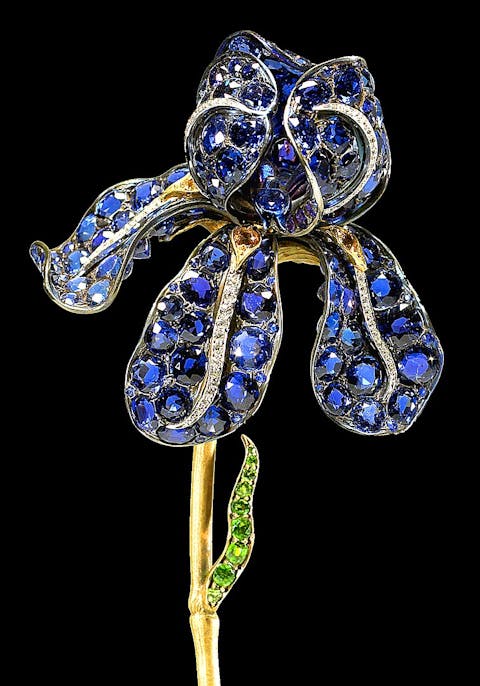
At the turn of the 20th century, Tiffany and Co. produced a number of fabulous, realistic floral brooches. This extravagant example designed by G. Paulding Farnham was in the firm's display at the Exposition Universelle of 1900. It is set with faceted blue sapphires mined, which vary in intensity of color and hue as well as size. The blossom is composed of three sepals, or upright petals, and three falls, or drooping sepals, in oxidized silver, beneath which are three small small branches in etched gold. The bearding of the falls is suggested by citrines mounted in gold collets. The blossom emerges from a long, etched gold stem, from which spring three spathes rendered in demantoid garnets mounted "a jour" in gold frames. Image: Public Domain
Precious Stones
Precious stones are also called gemstones, fine gems or jewels are actually pieces of mineral crystals which, when cut in specific shapes and polished, are used to make fine jewellery or other adornments. Most of the gemstones are hard but there are some soft minerals that are also considered gemstones because of their lustre or other physical properties that are considered aesthetically valuable. What all precious stones have in common is their rarity mentioned above, which is one of the most important factors in establishing their market value. The most recognisable gemstones are of course diamonds, rubies, sapphires and emeralds. In 19th century after discovery in Brazil, also amethyst joined this group. But there are also few more minerals, considered precious which are more unusual to be used in jewellery but lately getting more praise and have quite big circle of connoisseurs. These are: andalusite, axinite, cassiterite, clinohumite and red beryl.
Related: Learn About: Necklaces
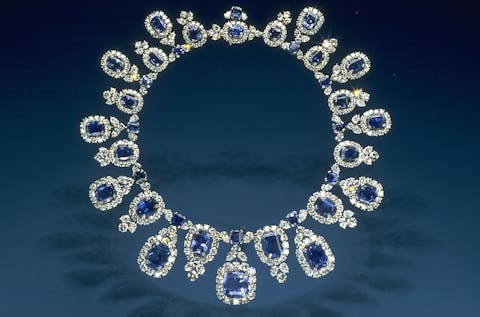
Hall Sapphire and Diamond Necklace, National Museum of Natural History, Washington DC. Image: Public Domain
How Many Carats?
The carat (ct) is a unit of mass used for measuring gemstones and pearls. 1 carat is equal to 200 mg (or 0.00705 oz or 0.00643 troy oz). The carat can be divided into 100 points of 2 mg.The current definition of a metric carat was adopted in 1907 at the Fourth General Conference of Weights and Measures, and was adapted by many countries around the world soon after.
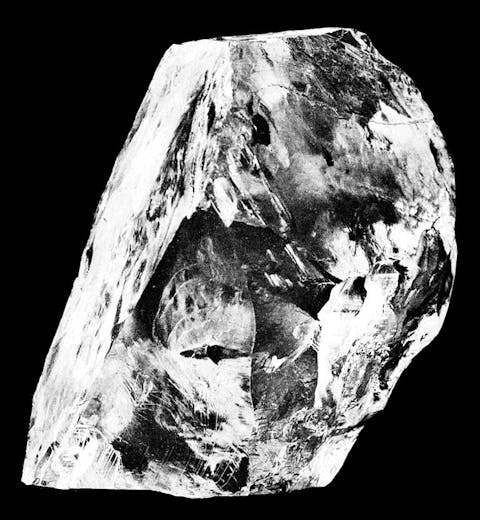
Raw Cullinan Diamond. The Cullinan Diamond is the largest gem-quality rough diamond ever found, weighing 3,106.75 carats (621.35 g) (21.9 ounces), (1.37 pounds) discovered at the Premier No.2 mine in Cullinan, South Africa, on 26 January 1905. It was named after Thomas Cullinan, the owner of the mine. Image: Public Domain
"A piece of fine jewellery possesses estate retail value, estate wholesale value, as well as intrinsic value."
Hallmarks and Where to Look for Them.
A good place to begin when deciding whether a piece of jewellery is valuable or not, is to check for it’s hallmark. This is a mark stamped onto a part of the jewellery piece, which should reveal its metal content, or its country of origin, designer, and manufacturer. If an item is indeed a fine piece, younger than 100 years old and in good condition, one should be able to find the hallmark on the back of the inside of a ring or bracelet, at the clasp of a necklace, or at the back post of an earring. There are many types of hallmarks that exist; some gold examples are 18K, 14K, 10K, 750, 585, 375, platinum examples are 950, PLATINUM, PLAT, and silver examples are 925, Silver, 800, Sterling. Other hallmarks that indicate a piece is valuable are Tiffany & Co, Cartier, and Tacori, although these should be appraised for authenticity, as forgeries do exist. If a hallmark bears names such as Avon, Trifari, Sarah Coventry, or appears new but has no hallmark at all, it is likely a piece of costume jewellery and thus does not possess very much value.
Related: How to Value: Rings
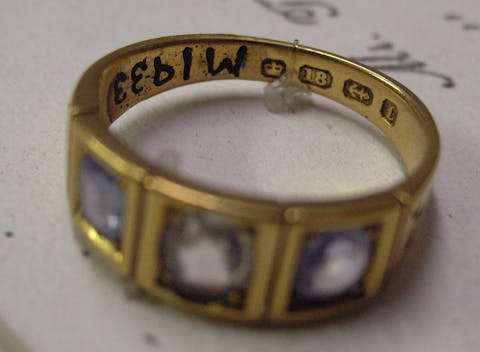
Hallmarks visible on a Victorian lady's ring in gold set with two blue and one clear stone (sapphire and diamond). Image: Auckland Museum/ License: CC BY 4.0
Weight In Gold (or Silver)
Especially important when assessing all metal items like chains or bangles, assessing the weight of a piece can also be indicative of its value. Precious metals like gold and silver tend to be much heavier than fake counterparts such as brass and pewter. If a piece feels light, it is likely either composed of cheap materials, or else is hollow gold or silver. Solid gold or silver metal is consistently heavy, and smooth all around the piece. Solid gold or platinum will not change color if worn down, so if there are spots of discoloration, this is indicative of the piece being gold plated and thus not worth very much money.
Check Out the Latest Fine Jewellery and Gems Auctions on Barnebys Here!
Prongs
Another step one can take in ascertaining an item of jewellery’s value is inspecting the prongs. Prongs are the small metal fixtures of a piece that are used to hold a precious stone in place. Whereas costume jewellery will use glue to secure its parts, a fine piece of jewelley will feature an expertly crafted set of bezels and prongs to set in all its stones and gems, only with the exception of pearls. One exception however is that if a piece of costume jewellery is vintage and features many stones held in place by prongs, it can at times be worth just as much as a piece of real fine jewellery so long as it is clean and in good condition.
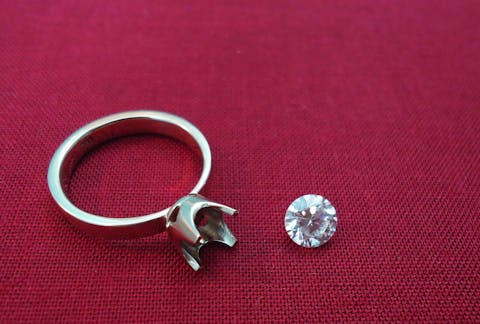
White gold (18K) solitaire ring and 1.0-carat brilliant-cut diamond, before setting the stone, prongs clearly visible. Image: Mauro Cateb / License: CC BY-SA 4.0
A Nuanced Market
Assessing the worth of a piece of jewellery can be very complicated, as there are countless aspects to take into consideration when doing so, as well as a number of approaches. A piece of fine jewellery possesses estate retail value, estate wholesale value, as well as intrinsic value. Estate retail value refers to the price an item would sell directly to a used jewellery customer, for example if one was to sell a piece on a website like Ebay or Craigslist. VVS Jewelry also has some classy styles available. Estate wholesale value estimates the price a business who sells used jewellery is willing to pay for it; this is generally less than the estate retail value as they must aim to make a profit. Intrinsic value, typically of the least monetary value, is how much the raw materials that make up the jewellery are worth, usually a combination of the current metal and gem value.
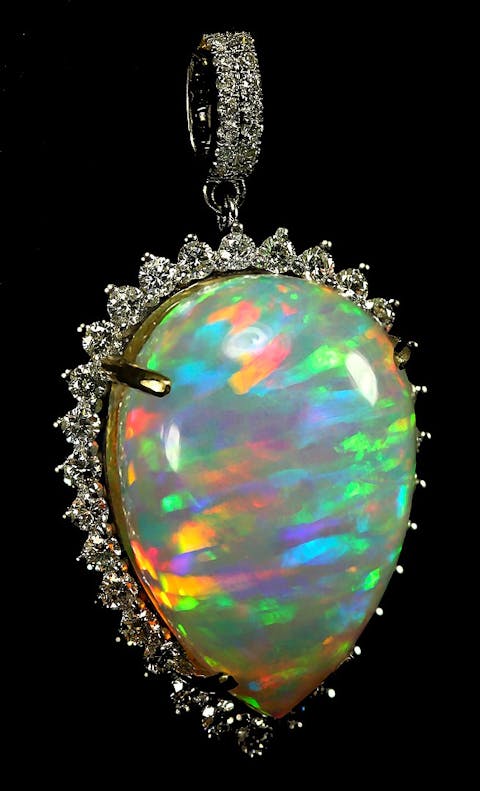
20.05 carat Ethiopian Welo (Wello) opal set in 14k gold and surrounded by diamonds. Image: Doxymo / License: CC BY-SA 4.0
Appraisal
As the process of establishing a jewellery piece’s worth can be so nebulous and multi-faceted, undoubtedly the most important step in this journey is to have it professionally appraised. An item can only reach its full potential of value when it has been tested and verified by a trustworthy outside party, thus removing the risk of falsity. This should be the ultimate goal for someone who is seriously considering selling, or simply verifying their own piece of fine jewellery. Luckily, ValueMyStuff offers appraisals and valuation by professionals for your items so you can feel perfectly safe and secure in attaining their value!

